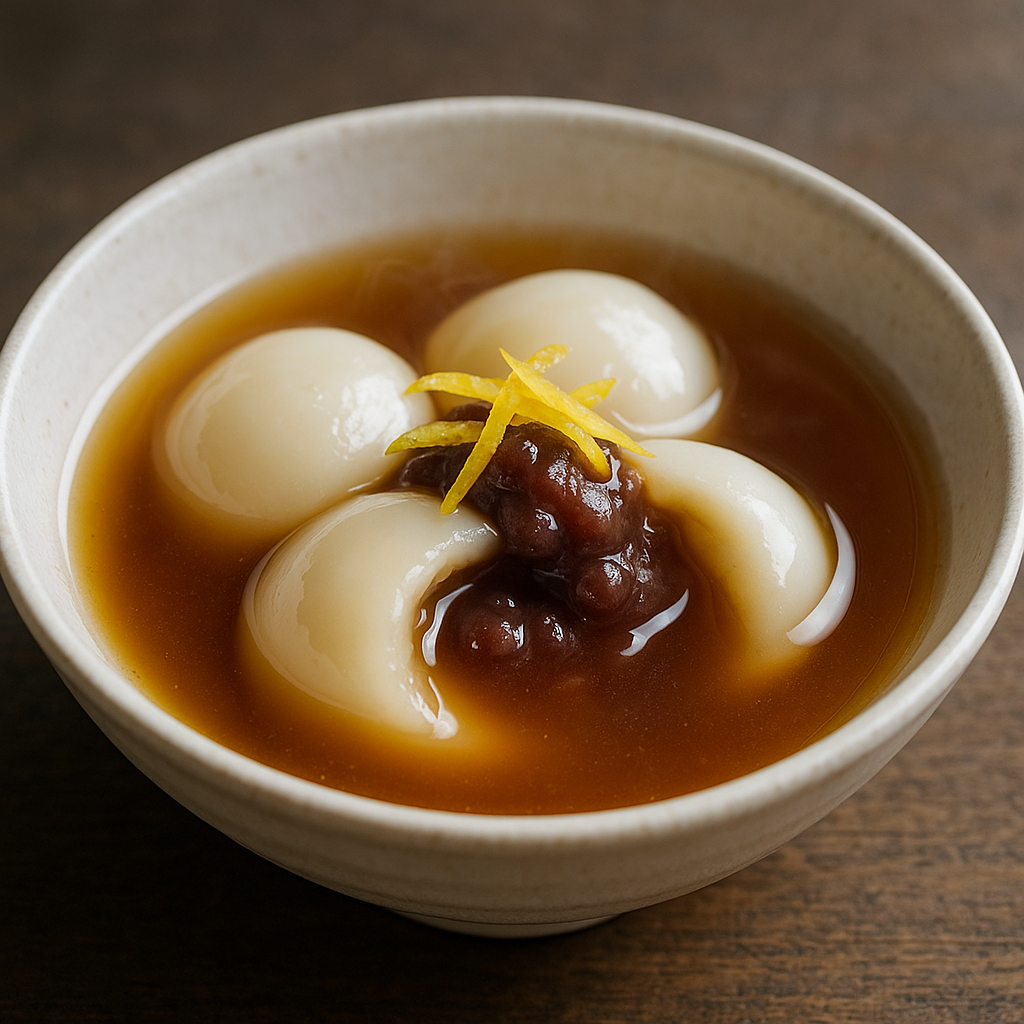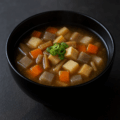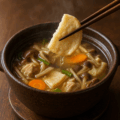けいらん(青森)の特徴
卵形のもちを澄ましに浮かべる行事食
けいらんは、卵の形に成形した餅の中にこしあんを包み、薄味の澄まし汁に浮かべていただく青森の郷土料理。甘いあんと醤油出汁の調和が上品です。
甘いあん × だしのうまみのコントラスト
昆布やかつおのだしに、淡い醤油と酒で整えた澄まし仕立て。甘味と塩味の対比が際立ち、後味はすっきり。
秋仕舞い・慶弔の席で親しまれる
もとは収穫を終える「秋仕舞い」のごちそう。現在は慶弔の膳にも供され、紅白や小振りなど場に応じたあしらいもあります。
けいらん(青森)のレシピ
材料(4人分/1人2個目安)
- 白玉粉 … 100g(またはもち粉 100g)
- ながいも(すりおろし) … 100g(コシと軽さを出す/省略可)
- ぬるま湯(約40〜50℃) … 適量(生地の固さで加減)
- こしあん … 160g(20g×8個)
- 柚子の皮…適量(千切り/あれば)
澄まし汁
- 水 … 1,000ml
- 昆布 … 5×10cm 1枚
- かつお節 … 15g
- 薄口醤油 … 大さじ2と1/2〜3
- 酒 … 大さじ2
- 塩 … 少々(味を見て調整)
作り方
- だし:鍋に水と昆布を入れて弱火で温め、沸騰直前に昆布を引き上げる。かつお節を加えて火を止め、2分置いてこす。薄口醤油・酒・塩で淡く調える。
- 生地:白玉粉とながいもを混ぜ、ぬるま湯を少しずつ加えて耳たぶ程度に。8等分して丸める。
- 包む:生地を円盤にのばし、こしあん20gを包んで口を閉じ、卵形に整える。
- ゆでる:沸騰した湯でやさしくゆで、浮いてから1分ほどで冷水に取り、ぬめりを流す。
- 仕上げ:澄まし汁を温め、椀にけいらんを2個ずつ入れて注ぎ、柚子の皮を乗せる。
シェフのワンポイントアドバイス
餅生地はやや固めに仕上げると煮崩れにくい。ゆで上げ後はぬめりを水で流し、提供直前に温かいだしへ。
甘みと塩味のバランスは薄口醤油少なめ→味見で足すのが失敗しにくいです。
栄養価(1人分の目安/けいらん2個+汁)
- エネルギー:約250〜340 kcal
- たんぱく質:5〜8 g
- 脂質:1〜3 g
- 炭水化物:50〜60 g
- 食物繊維(あん・しいたけ)/ヨウ素(昆布だし)
甘味はあんの量で調整可能。だしを薄めにすると全体の塩分も抑えられます。
歴史
秋仕舞いのごちそうから慶弔の膳へ
収穫期の「秋仕舞い」に振る舞われたのがはじまり。現在は冠婚葬祭でも供され、紅白や小振りのけいらんなど地域の作法が残ります。
上方の影響と北前船の伝播
上方の料理文化が北前船を通じて北東北へ伝わり、青森・下北に根づいたとされます。地域により配合や器のしつらえが異なります。
English Version
Features of Keiran (Aomori)
A Ceremonial Dish of Egg-Shaped Mochi in Clear Broth
Keiran is a local dish of Aomori in which egg-shaped mochi filled with smooth red bean paste are served in a lightly seasoned clear soup. The harmony of sweet anko and soy-based dashi is elegant.
Sweet Bean Paste × Dashi Umami Contrast
Kombu–katsuobushi dashi, finished gently with light soy sauce and sake, sets up a refined contrast of sweetness and saltiness with a clean aftertaste.
Loved for Harvest-Closure and Ceremonial Occasions
Originally a feast for the end of harvest (“aki-shimai”), it is now also served at celebratory and memorial gatherings, with variations like red–white coloring and smaller sizes.
Recipe
Ingredients (serves 4 / about 2 pieces per person)
- Shiratamako … 100 g (or mochiko 100 g)
- Nagaimo, grated … 100 g (adds elasticity and lightness; optional)
- Lukewarm water (about 40–50°C) … as needed (adjust for dough firmness)
- Koshian (smooth red bean paste) … 160 g (20 g × 8)
- Yuzu peel … to taste (julienned; if available)
Clear Broth
- Water … 1,000 ml
- Kombu … 1 piece (5 × 10 cm)
- Katsuobushi … 15 g
- Light soy sauce … 2½–3 tbsp
- Sake … 2 tbsp
- Salt … a little (adjust to taste)
Instructions
- Broth: Heat water with kombu over low heat; remove kombu just before boiling. Add katsuobushi, turn off the heat, steep 2 minutes, then strain. Season lightly with light soy sauce, sake, and a pinch of salt.
- Dough: Combine shiratamako and grated nagaimo. Add lukewarm water little by little until earlobe-soft. Divide into 8 portions and roll into balls.
- Wrap: Flatten each portion, enclose 20 g koshian, seal, and shape like an egg.
- Boil: Simmer gently in boiling water; once they float, cook about 1 minute more. Transfer to cold water and rinse off any surface starch.
- Finish: Warm the clear broth. Place 2 keiran in each bowl, ladle in broth, and garnish with yuzu peel.
Chef’s Tip
Make the mochi dough slightly firm to resist breaking. After boiling, rinse off the surface film and move to hot broth just before serving. For the sweet–salty balance, start with less light soy and add to taste after tasting the broth.
Nutritional Value (per person, approx.; 2 keiran + broth)
- Calories: 250–340 kcal
- Protein: 5–8 g
- Fat: 1–3 g
- Carbohydrates: 50–60 g
- Dietary fiber (from anko) / Iodine (from kombu dashi)
Sweetness can be adjusted by the amount of anko. Keeping the broth on the lighter side helps control overall salt.
History
From Harvest-Closure Feast to Ceremonial Fare
It originated as a dish served at the end of the harvest season. Today it appears at weddings and funerals as well, with regional customs like red–white pieces and petite sizes.
Kansai Influence via the Kitamae-bune Trade
Cooking traditions from the Kansai region are thought to have spread to northern Tohoku via the Kitamae-bune shipping routes, taking root in Aomori and Shimokita. Ratios and presentation vary by locale.



何でも質問してください!